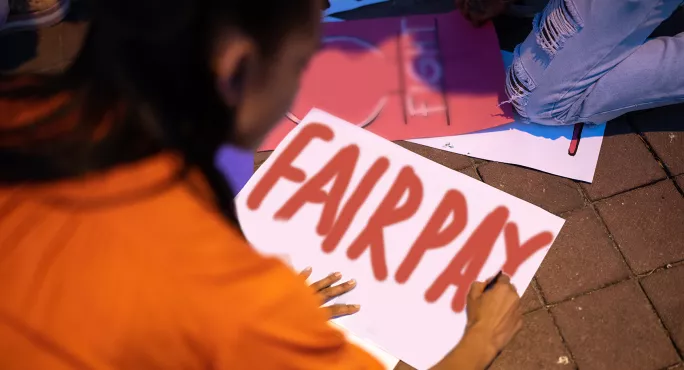Teacher strikes: How heads should handle walkouts

Ahead of the teacher strikes next month, school leaders’ union the NAHT has issued guidance to its members to help guide them on planning for the industrial action.
Ultimately, the NAHT says members should respect the actions of sister unions, but advises this should be “balanced with the responsibilities and legal duties that NAHT members have as senior leaders ensuring that they discharge their duties appropriately”.
- Weekly round-up: Teacher strikes to go ahead - all the latest
- Strike talks: ‘No progress’ made on teacher pay after union crunch talks
- Background: Teachers to strike in England from next month
Here is a snapshot of the key guidelines given to NAHT members.
Use of volunteers to plug staffing gaps
Earlier this week, the Department for Education suggested schools could consider using volunteers to support existing staff on upcoming strike days, as part of updated guidance that told schools to prioritise vulnerable children among other groups.
However, NAHT guidance advises that it has “legitimate concerns” about the use of volunteers, warning it could have “profoundly serious implications for the safety and wellbeing of pupils”.
The union warns that even where volunteers have current Disclosure and Barring Service (DBS) check certification, there are issues of “confidentiality”, “first aid training”, “knowledge of evacuation procedures in case of emergencies”, “safe use of equipment”, “behaviour management” and many other aspects to consider.
Picket lines
The union highlights that employers “have the right to refuse permission to picket on or inside any part of school or trust property”. It recommends leaders speak to their local authority or trust to understand their approach.
If pickets are allowed on or near school premises, NAHT recommends discussions with striking trade union representatives to agree permissions related to the picket line such as the use of school facilities by those picketing.
When it comes to the issue of staff who are not part of the union taking industrial action refusing to cross picket lines, the NAHT said it is seeking further clarification and will update members.
However, in the meantime, it said school leaders should refer to Local Government Association advice, which sets out the legal position for such staff depending on their membership of non-striking unions and those organisations’ strike ballot circumstances.
Risk assessments and safeguarding
The guidance also warns leaders to undertake a risk assessment relating to the potential impact of the action to determine if contingency plans could prove to be “unsafe” or “unworkable” and therefore not “operationally safe” for the school to stay open.
It sets out that the DfE strike guidance issued earlier this week is not statutory, and therefore a school leader’s statutory health and safety responsibilities should come first.
It also stresses that any decisions to change provision on strike days should not be politically motivated and be grounded in clear evidence under heads’ health and safety duties.
It adds that it could be “problematic” if a school’s “designated safeguarding lead (DSL) or deputy DSL (where there is no suitable alternative)” is not “available during school hours to discuss safeguarding concerns”, and advises leaders to seek advice if this is the case.
Early years ratios
At the early years foundation stage, leaders are also reminded that there are “specific rules” that require schools to meet staffing ratios and qualification requirements.
In an EYFS setting, if you cannot meet these requirements on strike days, “you cannot open to deliver EYFS provision”.
Differences for pupils with SEND and special schools
The NAHT advises that in provision for pupils with special educational needs and disabilities (SEND) there are “pupils who might need additional support or supervision, and this should be carefully considered when deciding if you have enough staff to safely open”.
And the union says the situation will “be more acute in special schools”.
It also reminds leaders that they must make sure at least one individual with a current paediatric first aid (PFA) certificate is always on the school premises.
Remote learning
The NAHT advice also makes clear that school leaders cannot ask staff who intend to strike to undertake preparatory work ahead of strikes.
It says an “employer cannot force a staff member who is taking legitimate industrial action to prepare lessons for remote learning or for use in school on the day of that industrial action”.
What you should ask of staff
While the NAHT acknowledges leaders will want to have an idea of numbers ahead of strike day, it advises that striking staff do not have to “confirm or deny” they are taking action.
If leaders will be asking staff, they should ask all staff, not just those they think could be trade union members, the union says.
It adds the trade union taking the industrial action is required to send notice of the action, containing details that can help the employer “readily to deduce” the total number of staff that may take part in the industrial action, their job category and workplace.
You need a Tes subscription to read this article
Subscribe now to read this article and get other subscriber-only content:
- Unlimited access to all Tes magazine content
- Exclusive subscriber-only stories
- Award-winning email newsletters
Already a subscriber? Log in
You need a subscription to read this article
Subscribe now to read this article and get other subscriber-only content, including:
- Unlimited access to all Tes magazine content
- Exclusive subscriber-only stories
- Award-winning email newsletters
topics in this article



